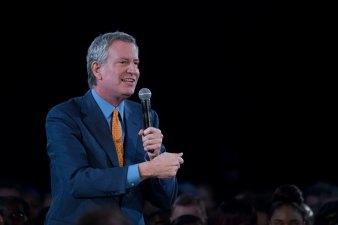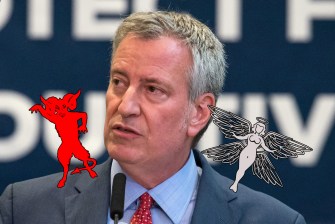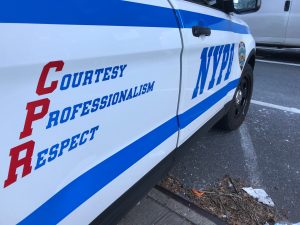Mayor Adams’s ‘Turbo-Charged’ Vision Zero Includes a Back Door to Massive NYPD Crackdown on Cyclists

Updated | Mayor Adams announced on Wednesday a new and previously undiscussed enforcement effort to punish drivers and cyclists who roll through intersections without stop signs — but his Department of Transportation commissioner claimed it would not lead to an NYPD crackdown against bike riders.
The new regulation regarding the roughly 1,200 non-signalized intersections was part of a larger announcement that focused on what could be called Vision Zero on steroids — an effort to crack down on reckless drivers with more enforcement of failure-to-yield violations plus a plan to bolster 1,000 of the city’s dangerous intersections this year with engineering improvements.
But given the NYPD’s long-documented bias against cyclists — who get a disproportionately high share of moving violation and red -light tickets, despite their disproportionately low contribution to injuries and death — activists said they were concerned about the new enforcement effort, which requires drivers and bike riders to come to a full stop if they see a pedestrian, and wait until the pedestrian has fully reached the other side of the street before resuming motion. The rule was drafted late in the de Blasio administration.
“If the police want to run up numbers of bike tickets, they already have ample scope to do that, new rule or not,” said Jon Orcutt, a former DOT official who is the director of advocacy for Bike New York. “If Mayor Adams and NYPD Commissioner [Keechant] Sewell want to focus on safety outcomes and reduce street fatalities for the first year since 2018, they will focus on where the damage is being done, and that’s by dangerous behavior behind the wheel of motor vehicles.”

Eric McClure of StreetsPAC, the political action committee that endorsed Adams in the November election, was also concerned.
“Pretty much anything is an opportunity for a crackdown on people riding bikes, but I hope that won’t be the case with this new rule,” he said. “The relative dangers created by a person driving a 6,000-pound SUV and a person riding a 25-pound bicycle are obviously widely divergent, but the impetus to protect pedestrians is the key thing here. … I don’t see police enforcing much of anything right now, honestly, so I’m not sure if this will change anything.”
Cyclist George Calderaro certainly disagrees. Calderaro, who works at Columbia University, was stopped and ticketed twice for going through red lights in 2018 by an officer who clearly targeted the bike rider on an empty Harlem street early one morning. As such, he is convinced that cyclists will end up being disproportionately targeted by cops.
“I have been fined and paid $2,445 for these two supposed violations where no one was endangered or even present, except a cop who was filling a quota or acting on a bias against bicyclists through entrapment, Calderaro said. “This proposal is an open invitation to cops with a quota, a bike bias or simply nothing else to do but run amok against all cyclists, including conscientious ones like me. It’s appalling that this comes from the the supposedly bike-friendly Adams, who is ignoring his own experience on the streets as he panders to New Yorkers who are rightfully upset by scofflaws on sidewalks and otherwise riding dangerously.”
The new regulation will likely enrage cyclists when they read the full text of it. Before the change was proposed in late November, the city rules were clearly focused on drivers of multi-ton vehicles.
“When traffic control signals or pedestrian control signals are not in place or not in operation, the operator of a vehicle shall yield the right of way to a pedestrian crossing a roadway within a crosswalk when the pedestrian is in the path of the vehicle or is approaching so closely thereto as to be in danger.”
Now, compare and contrast (new language is in bold; deleted language is in brackets):
“When traffic control signals or pedestrian control signals are not in place or not in operation, [the] any operator of a vehicle [shall yield the right of way to] or operator of a bicycle must stop for a pedestrian crossing a roadway within a crosswalk [when the pedestrian is in the path of the vehicle or is approaching so closely thereto as to be in danger]. Such operators of vehicles and operators of bicycles in any lane of travel must stop and remain stopped for a pedestrian in crosswalk until such pedestrian crosses a roadway.”
Clearly, someone wanted to make sure bicyclists are subject to this new rule.
DOT Commissioner Ydanis Rodriguez, a longtime supporter of cycling and a critic of NYPD anti-cyclist enforcement efforts when he was a member of the City Council, said he did not believe the new rule was intended to create a massive drift net for fishing expeditions by the NYPD.
“We will see what is the impact when it comes to the cyclists community,” he told Streetsblog. “Pedestrians are the ones that we are so committed to protecting in this particular initiative. I don’t see that this rule, which is in effect today, is doing anything more than protecting the pedestrians. If by any chance there are cases related to cyclists being a target, we will be working with the cyclists community.”
In addition to the rule change announced on Wednesday, key Adams administration officials including the mayor, NYPD Commissioner Keechant Sewell and NYPD Transportation Bureau Chief Kim Royster, and Rodriguez, journeyed to the belly of the beast — Coney Island and Caton avenues — to announce other moves designed to make New York City safer for pedestrians and cyclists. The announcement came after the bloodiest year of the eight-year Vision Zero initiative, when 122 pedestrians were killed.
At that single intersection, there have been 95 reported crashes over the last five years, injuring 26 people. All of Coney Island Avenue was made a Vision Zero priority zone in 2015, but little was done. In 2021 alone, there were 284 reported crashes on Coney Island Avenue between Prospect Park and the Belt Parkway, a strip of just four miles, injuring 20 cyclists, 31 pedestrians and 104 motorists, according to city statistics.
“After the tragedy of 2021, we clearly need to turbo-charge Vision Zero — and fast,” Adams said, reiterating that road safety is a key priority for him.
“I say this over and over again: the prerequisite to prosperity is public safety and justice,” he said. “And sometimes when we think about public safety, we think about the gun violence that we are witnessing in our city. But it’s also about the traffic crashes. … The cornerstone of my administration is about creating a safe city for New Yorkers. … And these fatalities are happening, these injuries are happening, because people want to cross the street. Just to cross the street! They are feeling the trauma that comes with it. Unacceptable.”
The citywide initiative calls for:
- Improvements at 1,000 of the “worst” intersections — which are still being determined — with wider use of the existing DOT toolkit:
- Changes in turn signals and more leading pedestrian intervals to give walkers a head start against drivers.
- Raised crosswalks: DOT will construct 100 raised crosswalks every year, up from the 17 that the agency installed in all the de Blasio years. Raised crosswalks serve a dual purpose by increasing accessibility for the disabled, while also functioning as a speed bump, Rodriguez said.
- The DOT will place bike corrals — which are going in as part of the agency’s effort to create 10,000 new bike-parking spaces by the end of the year — at intersections to effectively “daylight” at least 100 intersections this year. The agency says that placement of the corrals will also prevent drivers from cutting corners and turning too quickly.
- Targeting — to start — a dozen locations (typically parking lots and gas stations) where drivers use curb cuts to get around traffic lights (see photo below). The intersection where the press release was taking place has two such gas stations that are frequently used by drivers as short cuts around traffic lights. There are bus stops on several sidewalks and locals say they have seen drivers literally drive through a line of people waiting for a bus.
- Turn calming: The DOT says it will double the installation of turn-slowing bumpouts, fixing 100 intersections this year. “We know drivers take turns more slowly and deliberately when physical elements force them to turn at a more appropriate speed,” Rodriguez said.
- Increased enforcement by the NYPD:
- Officers will enforce the new rule at non-signalized intersections.
- Also, the agency says it will “strongly enforce” failure-to-yield violations with a “goal of doubling” the failure-to-yield enforcement effort in 2021, when the number of tickets written by cops dropped dramatically. NYPD Commissioner Sewell said the agency would not add officers to write more failure-to-yield tickets, telling Streetsblog, “It’s not so much that we’re going to have additional officers [but that] every officer is going to be focused on it. When they see these infractions they will be enforced.”
- A vague public awareness campaign called “Stop. Let Them Cross”
- The DOT “will begin a public awareness campaign on social media and in community and ethnic media publications to raise awareness for the new stop for pedestrians’ rule for uncontrolled intersections.”

Given that most of the announcement focused on redesigning intersections — where the vast majority of injury-causing crashes happen — Transportation Alternatives Executive Director Danny Harris was pleased.
“Investment in safe street design is how we will achieve Vision Zero,” Harris said in a statement. “The concrete solutions announced today will better prevent drivers from speeding and protect our most vulnerable road users, like seniors, children, and everyone who bikes. This effort must be coupled with additional actions that reduce the number of dangerous vehicles citywide, and, as we’ve put forward in our NYC 25×25 vision, also reclaim street space that better serves our public health, climate, and the local economy. Today’s emphasis on infrastructure is the right approach.”
Above all, Adams, Sewell and Rodriguez spoke of a new Vision Zero partnership — one that de Blasio administration officials always championed but never pulled off because of well-documented disregard by the NYPD.
“You will see a better coordination and enforcement with the New York City Police Department,” Adams said. “We’re not going to wait until there’s a fatality before we identify where the problem is located and have the proper enforcement when we do so. … As you know, I walk, I bike, I like to use the streets as much as possible to get around. And we want to encourage that. But you can’t encourage it if you have the level of fatalities that we’re seeing. And it impacts communities of color, poor communities, immigrant communities.”
Sewell referred to last year’s bloodshed and said she was a willing safety partner.
“We’re going to change the outcome and create a safer New York for pedestrians,” she said. “We need to change the behavior that causes the crashes. We will do that through enforcement and public awareness. Slow down and stop if you see a pedestrian crossing the intersection. That does not mean slow down and navigate your car in between people walking in the crosswalk. It means stop until the crosswalk is clear of pedestrians and then proceed. … We’ve issued warnings, but the time for warnings has come to an end and it’s time to obey this law. And we will be out there to ensure compliance. … It’s a partnership meant to save lives.”





